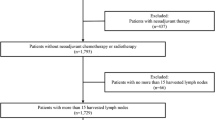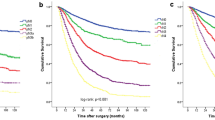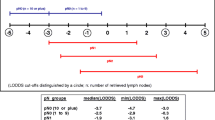Abstract
Background
Our aim was to establish a new pN staging system for gastric cancer based on the number and location of metastatic lymph nodes (MLNs) and to compare it with other systems.
Methods
We retrospectively analyzed the prognostic data of 521 gastric cancer patients who underwent curative resection. Survival analyses were used to establish a pN staging system that considers both the number and location of MLNs and to compare discriminatory ability and monotonicity of gradients (linear trend χ 2 score), homogeneity ability (likelihood ratio test), and prognostic stratification ability (Akaike information criterion) between Japanese Gastric Cancer Association (JGCA) and Union for International Cancer Control (UICC) systems.
Results
Cut-point survival analysis divided pN+ patients into two groups: Nxn1~6 and Nxn≥7. N0, N1, N2, and N3 (the previous classifications) were replaced by N0, N1n1~6, N2n1~6, and N1n≥7 + N2n≥7 + N3n1~6 + N3n≥7, respectively. Compared with two widely used staging systems, the new system had the highest likelihood ratio test [106.06 (new) vs 95.09 (JGCA) vs 94.33 (UICC)] and linear trend χ 2 scores [102.30 (new) vs 89.12 (JGCA) vs 86.97(UICC)] and the lowest Akaike information criterion (AIC) score [2,283.88 (new) vs 2,285.31 (JGCA) vs 2,299.88 (UICC)].
Conclusion
A new pN staging system based on the number and location of MLNs is an efficient prognostic indicator of the survival of patients with gastric cancer following radical surgery.



Similar content being viewed by others
References
Kamangar F, Dores GM, Anderson WF. Patterns of cancer incidence, mortality, and prevalence across five continents: defining priorities to reduce cancer disparities in different geographic regions of the world. J Clin Oncol. 2006; 24(14):2137–50.
Jemal A, Siegel R, Ward E, et al. Cancer statistics, 2008. CA Cancer J Clin. 2008;58(2):71–96
Wang YC, Wei LJ, Liu JT, et al. Comparison of Cancer Incidence between China and the USA. Cancer Biol Med. 2012;9(2):128–132.
Deng JY, Liang H.. Clinical significance of lymph node metastasis in gastric cancer. World J Gastroenterol. 2014;20(14):3967–3975.
Cambruzzi E, Azeredo AM, Kronhart A et al. The presence of metastases in regional lymph nodes is associated with tumor size and depth of invasion in sporadic gastric adenocarcinoma. Arq Bras Cir Dig. 2014;27(1):18–21.
Fleming ID, Cooper JS, Henderson DE. AJCC cancer staging manual, 5th edition. New York: Springer, 1997.
Edge SB, Byrd DR, Compton CC, et al. American Joint Committee on Cancer (AJCC) cancer staging manual. 7th ed. Chicago: Springer, 2010.
Japanese Gastric Cancer Association. Japanese gastric cancer treatment guidelines 2010 (ver. 3). Gastric Cancer. 2011. 14(2):113–123.
Fielding LP, Fenoglio-Preiser CM, Freedman LS. The future of prognostic factors in outcome prediction for patients with cancer. Cancer. 1992;70(9):2367–77.
Japanese Gastric Cancer Association. Japanese classification of Gastric Cancer-14th edition (2010) -. KANEHARA & CO., LTD; Tokyo (Japanese)
Kunisaki C, Shimada H, Nomura M, et al. Comparative evaluation of gastric carcinoma staging: Japanese classification versus new american joint committee on cancer/international union against cancer classification. Ann Surg Oncol. 2004;11(2):203–6.
Hayashi H, Ochiai T, Suzuki T, Shimada H, Hori S, Takeda A, et al. Superiority of a new UICC-TNM staging system for gastric carcinoma. Surgery. 2000;127(2):129–35.
Hidaka H, Eto T, Maehara N, Jimi S, Hotokezaka M, Chijiiwa K. Comparative effect of lymph node metastasis classified by the anatomical site or by the number of nodes involved on prognosis of patients with gastric cancer. Hepatogastroenterology. 2008;55(88):2269–72.
Ichikura T, Tomimatsu S, Uefuji K, Kimura M, Uchida T, Morita D, et al. Evaluation of the New American Joint Committee on Cancer/International Union against cancer classification of lymph node metastasis from gastric carcinoma in comparison with the Japanese classification. Cancer. 1999;86(4):553–8.
Celen O, Yildirim E, Gülben K, Berberoğlu U. Prediction of survival in gastric carcinoma related to lymph node grading by the new American Joint Committee on Cancer/Union International Contre le Cancer System or the Japanese system. Eur J Surg Suppl. 2003;(588):33–9.
Bonenkamp JJ, Songun I, Hermans J, Sasako M, Welvaart K, Plukker JT, et al. Randomised comparison of morbidity after D1 and D2 dissection for gastric cancer in 996 Dutch patients. Lancet 1995; 345(8952):745–8.
Cuschieri A, Fayers P, Fielding J, Craven J, Bancewicz J, Joypaul V, et al. Postoperative morbidity and mortality after D1 and D2 resections for gastric cancer: Preliminary results of the MRC randomized controlled surgical trial. Lancet. 1996;347(9007):995–9.
Feinstein AR, Sosin DM, Wells CK. The Will Rogers phenomenon. Stage migration and new diagnostic techniques as a source of misleading statistics for survival in cancer. N Engl J Med. 1985;312(25):1604–8.
Ohno S, Tachibana M, Shibakita M, Dhar DK, Yoshimura H, Kinugasa S, et al. Prognostic significance of Fas and Fas ligand system-associated apoptosis in gastric cancer. Ann Surg Oncol. 2000;7(10):750–7.
Yamashita K, Sakuramoto S, Kikuchi S, Katada N, Kobayashi N, Watanabe M. Validation of staging systems for gastric cancer. Gastric Cancer. 2008;11(2):111–8.
Ikeguchi M, Murakami D, Kanaji S, Ohro S, Maeta Y, Yamaguchi K, et al. Lymph node metastasis of gastric cancer: comparison of Union International Contra Cancer and Japanese systems. ANZ J Surg. 2004;74(10):852–4.
Tong JH, Sun Z, Zhu Z, et al. Prognostic significance of lymph node station 7 for patients with gastric cancers underwent radical surgery. J Surg Oncol. 2012. 105(8):805–812.
Kim JP, Yang HK, Oh ST. Is the new UICC staging system of gastric cancer reasonable? (Comparison of 5-year survival rate of gastric cancer by old and new UICC stage classification). Surg Oncol. 1992;1(3):209–13.
Li F, Zhang R, Liang H, et al. The pattern of lymph node metastasis and the suitability of 7th UICC N stage in predicting prognosis of remnant gastric cancer. J Cancer Res Clin Oncol. 2012. 138(1):111–117.
Deng J, Liang H, Sun D, et al. Suitability of 7th UICC N stage for predicting the overall survival of gastric cancer patients after curative resection in China. Ann Surg Oncol. 2010. 17(5):1259–1266.
Deng JY, Liang H, Sun D, et al. The most appropriate category of metastatic lymph nodes to evaluate overall survival of gastric cancer following curative resection. J Surg Oncol. 2008;98(5):343–8.
Ueno S, Tanabe G, Sako K, Hiwaki T, Hokotate H, Fukukura Y, et al. Discrimination value of the new western prognostic system (CLIP score) for hepatocellular carcinoma in 662 Japanese patients. Cancer of the Liver Italian Program. Hepatology. 2001;34(3):529–34.
Adachi Y, Kitano S, Sugimachi K. Surgery for gastric cancer:10-year experience worldwide. Gastric Cancer. 2001;4(4):166–74.
Grant Support
This study was supported by research grants from the National Nature Science Foundation of China (No. 30972883)
Conflict of Interest
The authors declare they have no conflict of interests (financial, professional, or personal) which are relevant to the manuscript.
Author Contributions
Dr. Chen Jianhui and Dr. Chen Chuangqi contributed equally to this study, including study concept and design, analysis and interpretation of data, drafting of the manuscript, and critical revision of the manuscript for important intellectual content. Dr. He Yulong, Wu KaiMing, and Wu Hui participated in the acquisition of data and statistical analysis. Dr. Cai Shirong supervised the whole study as well as monitored the standard surgical operations. All the authors took part in the surgical operations for gastric cancer.
Author information
Authors and Affiliations
Corresponding author
Rights and permissions
About this article
Cite this article
Jianhui, C., Chuangqi, C., Yulong, H. et al. A New pN Staging System Based on Both the Number and Anatomic Location of Metastatic Lymph Nodes in Gastric Cancer. J Gastrointest Surg 18, 2080–2088 (2014). https://doi.org/10.1007/s11605-014-2663-5
Received:
Accepted:
Published:
Issue Date:
DOI: https://doi.org/10.1007/s11605-014-2663-5




